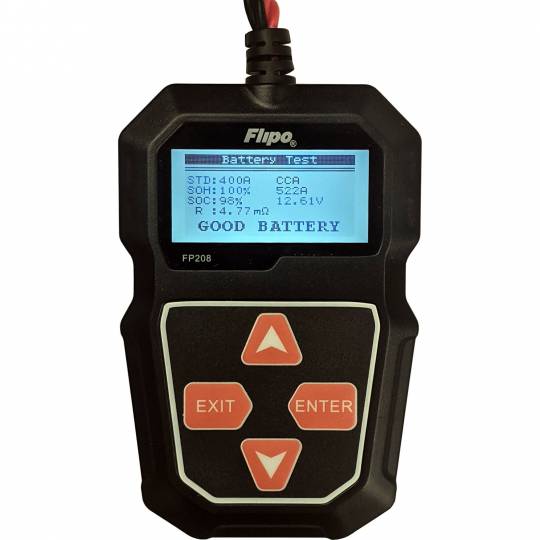Automotive battery testers measure the voltage and overall health of a vehicle’s battery. They provide readings to assess the battery’s charge and condition.
Automotive battery testers are essential tools for both car owners and mechanics. These devices quickly check a battery’s voltage, internal resistance, and overall condition. By connecting the tester to the battery terminals, users receive instant feedback on the battery’s performance.
This helps determine whether the battery needs charging, maintenance, or replacement. Regular testing ensures optimal vehicle performance and prevents unexpected breakdowns. Using a battery tester is straightforward and saves time and money by identifying issues early. Investing in a reliable automotive battery tester can significantly enhance vehicle reliability and longevity.

Introduction To Automotive Battery Testers
An automotive battery tester is a handy tool for vehicle maintenance. It helps ensure your car battery is in good condition. Understanding how these testers work can save you time and money.
Importance Of Battery Testing
Battery testing is crucial for several reasons:
- Ensures your car starts reliably.
- Prevents unexpected breakdowns.
- Extends battery life by detecting issues early.
Regular testing helps catch problems before they become serious. It can also help you avoid being stranded with a dead battery.
Types Of Battery Testers
There are different types of battery testers available:
| Type | Description |
|---|---|
| Load Testers | Apply a load to the battery and measure voltage drop. |
| Conductance Testers | Measure the conductance of the battery to assess health. |
| Multimeters | Measure voltage, current, and resistance of the battery. |
Each type has its own benefits and uses. Load testers are often used by professionals. Conductance testers are quick and easy to use. Multimeters offer more detailed information.
Choosing the right battery tester depends on your needs. For casual use, a conductance tester might be enough. For more detailed checks, consider a multimeter.
Core Functions
Automotive battery testers are essential tools for car owners and mechanics. These devices help evaluate the health and functionality of car batteries. Understanding their core functions ensures you get the most out of your battery tester.
Voltage Measurement
Voltage measurement is a critical function of battery testers. It checks the electrical potential difference between two points in the battery. This measurement helps determine if the battery is fully charged, partially charged, or depleted.
Voltage is usually measured in volts (V). A healthy car battery typically shows between 12.4V and 12.7V when fully charged. If the voltage drops below 12V, the battery might need charging or replacement.
Voltage measurement can also detect overcharging issues. A voltage reading above 14.7V might indicate a problem with the car’s charging system.
Conductance Testing
Conductance testing is another vital function. It measures the battery’s ability to conduct electrical current. This test helps identify internal battery issues like corrosion or sulfation.
Conductance testing involves sending a small AC signal through the battery. The tester then measures the response to this signal. Higher conductance values indicate a healthier battery.
Conductance testing is quick and provides accurate results. It is often preferred over load testing because it does not drain the battery.
Here is a simple table illustrating the typical conductance values:
| Battery Condition | Conductance Value (Siemens) |
|---|---|
| Good | Above 400S |
| Fair | 200S – 400S |
| Poor | Below 200S |
Using these core functions, automotive battery testers can effectively diagnose and maintain your car battery’s health.
Key Components
Understanding the key components of an automotive battery tester is crucial. These components ensure accurate readings and reliable performance. Below, we delve into the essential parts of these devices.
Display Interface
The display interface is where you view results. It shows battery health, charge level, and other data. Modern testers use digital screens. These screens offer clear and easy-to-read information. Some advanced models even provide graphical displays.
Here are key features of display interfaces:
- Digital Readout: Shows precise numerical values.
- Backlit Screen: Enables visibility in low light.
- Graphical Display: Offers visual data representation.
- Touchscreen Controls: Simplifies navigation and settings.
Testing Probes
Testing probes connect the tester to the battery. They transmit electrical signals to measure voltage and resistance. Probes come in different styles, each suited for specific tasks.
Common types of testing probes include:
- Alligator Clips: Versatile and easy to attach.
- Needle Probes: Ideal for piercing wire insulation.
- Clamp Probes: Securely hold onto battery terminals.
The quality of probes affects test accuracy. High-quality probes provide more reliable readings. Always ensure probes are clean and undamaged for the best results.
| Component | Function |
|---|---|
| Display Interface | Shows test results and battery information |
| Testing Probes | Connect the tester to the battery |

How They Work
Automotive battery testers are essential tools for car owners. They help determine the health of a car battery. Understanding how they work can help you use them effectively.
Connection Setup
To begin, locate the battery terminals. The positive terminal is usually marked with a red cover or a plus sign (+). The negative terminal has a black cover or a minus sign (-).
- Turn off your car engine.
- Connect the red clamp to the positive terminal.
- Attach the black clamp to the negative terminal.
Ensure the clamps are secure. This prevents inaccurate readings.
Reading Interpretation
After connecting, the tester will display the battery status. Most testers show voltage and charge level.
| Voltage Reading | Battery Status |
|---|---|
| 12.6V or higher | Fully charged |
| 12.4V to 12.6V | Normal charge |
| 12.0V to 12.4V | Low charge |
| Below 12.0V | Needs charging |
Some testers also indicate the cranking amps and internal resistance. High internal resistance means the battery is aging.
Modern testers often have an LCD screen for easy reading. Follow the on-screen instructions for best results.
Advanced Features
Automotive battery testers have evolved with advanced features. These features enhance functionality and user experience. They make battery testing more precise and efficient.
Digital Vs Analog
There are two main types of battery testers: digital and analog. Digital testers display results on an LCD screen. They are easy to read and use. Analog testers have a needle and scale. They are simpler but less precise.
Digital testers often include additional functions. These can measure voltage, current, and resistance. They provide accurate readings and detailed information. Analog testers are more basic but reliable. They suit simple testing needs.
Built-in Diagnostics
Built-in diagnostics are a key feature of modern testers. They help identify battery health issues. These diagnostics can detect sulfation, a common battery problem. They can also test for battery capacity and charge level.
Some testers offer advanced diagnostics. These include load testing and cranking tests. Load testing measures battery performance under stress. Cranking tests check the battery’s ability to start the engine.
| Feature | Digital Testers | Analog Testers |
|---|---|---|
| Display | LCD Screen | Needle and Scale |
| Accuracy | High | Moderate |
| Additional Functions | Yes | No |
Both digital and analog testers have their uses. Choose one based on your specific needs. Built-in diagnostics make battery testers more versatile. They help ensure your battery is in top condition.
Choosing The Right Tester
Selecting the right automotive battery tester is crucial. A good tester ensures your car battery remains healthy. There are several factors to consider. Let’s dive into these key points.
Budget Considerations
First, determine your budget. Battery testers come in various price ranges. Basic testers are cheaper. They offer essential features like voltage checks. More advanced testers cost more. They provide detailed diagnostics and additional functionalities.
| Price Range | Features |
|---|---|
| $20 – $50 | Basic voltage tests, simple interface |
| $51 – $100 | Load testing, battery health indicator |
| $101 and above | Advanced diagnostics, memory storage, connectivity options |
Consider your needs. If you want basic checks, a low-cost tester suffices. For detailed information, invest in a more advanced model.
Brand Comparisons
Several brands offer automotive battery testers. Popular brands include Schumacher, Midtronics, and Foxwell. Each brand has unique offerings.
- Schumacher: Known for reliability and durability.
- Midtronics: Offers advanced technology and precise results.
- Foxwell: Provides user-friendly interfaces and comprehensive testing options.
Read reviews. Customer feedback helps gauge a product’s reliability. Compare features and prices. Choose a brand that suits your requirements best.
Warranty. Opt for testers with good warranty terms. This ensures support in case of defects or issues.
Making an informed decision is key. Consider your budget and brand reliability. This ensures you get the best value for your money.
Common Issues
Automotive battery testers are essential tools. They help diagnose battery health. But, they can face common issues. These issues can affect their accuracy and reliability. Understanding these problems is important for accurate readings.
False Readings
Battery testers may sometimes give false readings. This can happen due to various factors. For instance, poor connection between the tester and battery terminals. Dirt or corrosion can also play a role. Another cause is low battery power in the tester itself.
To avoid false readings, ensure clean terminals. Use a tester with a full charge. Regularly inspect the tester for any damage. Simple steps can lead to accurate results.
Calibration Needs
Battery testers need regular calibration. Calibration ensures the tester provides accurate data. Without it, the tester might give wrong results. This can lead to incorrect diagnosis.
Manufacturers usually provide calibration instructions. Follow these steps carefully. Some testers have automatic calibration features. Check the user manual to understand your device. Regular calibration can save time and money.
Here’s a quick look at the issues and solutions:
| Issue | Solution |
|---|---|
| False Readings | Clean terminals, full charge, inspect for damage |
| Calibration Needs | Follow manufacturer’s instructions, regular checks |
Maintenance Tips
Maintaining your automotive battery tester is crucial. It ensures accurate readings and extends the device’s lifespan. Follow these maintenance tips to keep your tester in top shape.
Regular Calibration
Calibration is essential for accurate readings. Calibrate your tester at least once every six months.
- Follow the manufacturer’s instructions.
- Use a known reference battery.
- Check the calibration with a professional service if needed.
Regular calibration prevents errors. It ensures your tester remains reliable.
Proper Storage
Storing your battery tester correctly prevents damage. Keep it in a dry, cool place.
- Avoid direct sunlight.
- Store in its original case.
- Keep away from moisture.
Proper storage extends the life of your tester. It also maintains its performance.
Future Trends
The world of automotive battery testers is evolving rapidly. New technologies are shaping the future of battery diagnostics. These advancements make testing batteries easier and more accurate.
Smart Testers
Smart testers are the future of battery diagnostics. They use advanced algorithms to analyze battery health. This means they provide more accurate results than traditional testers.
Smart testers often include features like:
- Automatic test procedures
- Comprehensive data analysis
- Real-time feedback
These features help users understand the battery’s condition better. Smart testers can also store previous test results. This makes it easy to track the battery’s performance over time.
Integration With Mobile Apps
Integration with mobile apps is a growing trend. Mobile apps can connect to battery testers via Bluetooth or Wi-Fi. This allows users to view test results on their smartphones or tablets.
Benefits of mobile app integration include:
- Easy access to test results
- Data storage and management
- Remote diagnostics
Mobile apps can also provide additional features. For example, they can offer maintenance tips or reminders. This ensures the battery remains in good condition.
Some mobile apps even use cloud technology. This allows users to share data with professionals for expert advice.
| Feature | Benefit |
|---|---|
| Automatic Test Procedures | Reduces human error |
| Comprehensive Data Analysis | Provides accurate results |
| Real-Time Feedback | Improves user understanding |
| Data Storage | Tracks battery performance |
| Mobile App Integration | Easy access to results |
| Remote Diagnostics | Expert advice available |

Frequently Asked Questions
How Do Automotive Battery Testers Work?
Automotive battery testers measure voltage, current, and resistance. They assess the battery’s health by analyzing these metrics.
What Does A Battery Tester Measure?
A battery tester measures voltage, current, and internal resistance. These metrics help determine the battery’s health and performance.
Can A Battery Tester Check Alternator Output?
Yes, many automotive battery testers can check alternator output. This helps ensure the charging system works properly.
How Accurate Are Automotive Battery Testers?
Automotive battery testers are generally accurate. However, their precision can vary based on the model and brand.
Conclusion
Understanding how automotive battery testers work can help you maintain your vehicle’s efficiency. Regular testing ensures your battery’s health and longevity. Investing in a reliable battery tester saves time and money. Stay proactive and keep your car running smoothly. Remember, a well-maintained battery means fewer roadside emergencies.




